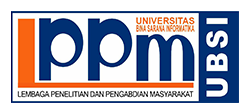KETERLIBATAN MEREK TERHADAP KEPUASAN DAN NIAT BERKUNJUNG KEMBALI KONSUMEN RESORT TERPADU
Abstract
Penelitian ini bertujuan untuk mendapatkan pengetahuan tentang pengalaman konsumen menuju resort terpadu di Pulau Bangka. Persepsi konsumen terhadap resort terpadu didapatkan melalui survei menggunakan teknik convenience sampling yang berjumlah 157 responden. Nilai pengalaman berdasarkan suasana dan keunggulan layanan ditelusuri dampaknya terhadap keterlibatan merek yang berujung kepada kepuasan konsumen serta niat berkunjung kembali. Data dianalisis menggunakan Partial Least Square-Structural Equation Model (PLS-SEM). Hasil penelitian menunjukkan bahwa keunggulan layanan resort dapat mempengaruhi secara signifikan dibandingkan dengan suasana resort terhadap keterlibatan konsumen dalam merek resort. Keterlibatan tersebut mempengaruhi kepuasan konsumen dan niat perilaku mereka. Akan tetapi kepuasan konsumen tidak dapat mempengaruhi niat berkunjung kembali para konsumen yang dimungkinkan hanya puas untuk satu kali perjalanan. Hal itu terjadi dimungkinkan karena faktor suasana yang dianggap penulis masih perlu ditingkatkan. Penelitian ini mengeksplorasi wawasan ke dalam hubungan antara nilai pengalaman berdasarkan suasana dan keunggulan layanan serta niat perilaku konsumen dalam manajemen resort terpadu.
Keywords
Full Text:
PDF (Bahasa Indonesia)References
Ahn, J., & Back, K. J. (2018). Antecedents and consequences of customer brand engagement in integrated resorts. International Journal of Hospitality Management, 75, 144-152.
Aksoy, L., van Riel, A., Kandampully, J., Wirtz, J., den Ambtman, A., Bloemer, J., ... & Canli, Z. G. (2013). Managing brands and customer engagement in online brand communities. Journal of Service Management.
Ali, F., Amin, M., & Cobanoglu, C. (2016). An integrated model of service experience, emotions, satisfaction, and price acceptance: an empirical analysis in the Chinese hospitality industry. Journal of Hospitality Marketing & Management, 25(4), 449-475.
Ali, F., Rasoolimanesh, S. M., Sarstedt, M., Ringle, C. M., & Ryu, K. (2018). An assessment of the use of partial least squares structural equation modeling (PLS-SEM) in hospitality research. International Journal of Contemporary Hospitality Management.
Badan Pusat Statistik. (2020). Statistik Pariwisata Provinsi Bangka Belitung. Retrieved from https://babel.bps.go.id/ subject/181/pariwisata.html#subjekViewTab3
Carlson, J., Rosenberger III, P. J., & Rahman, M. M. (2016). A hierarchical model of perceived value of group-oriented travel experiences to major events and its influences on satisfaction and future group-travel intentions. Journal of Travel & Tourism Marketing, 33(9), 1251-1267.
Chan, A., Hsu, C. H., & Baum, T. (2015). The impact of tour service performance on tourist satisfaction and behavioral intentions: A study of Chinese tourists in Hong Kong. Journal of Travel & Tourism Marketing, 32(1-2), 18-33.
Chathoth, P. K., Ungson, G. R., Harrington, R. J., & Chan, E. S. (2016). Co-creation and higher order customer engagement in hospitality and tourism services. International Journal of Contemporary Hospitality Management.
Hair Jr, J. F., Sarstedt, M., Hopkins, L., & Kuppelwieser, V. G. (2014). Partial least squares structural equation modeling (PLS-SEM). European business review.
Hair Jr, J. F., Sarstedt, M., Ringle, C. M., & Gudergan, S. P. (2017). Advanced issues in partial least squares structural equation modeling. Sage publications.
Han, H., & Ryu, K. (2007). Moderating role of personal characteristics in forming restaurant customers' behavioral intentions: An upscale restaurant setting. Journal of Hospitality & Leisure Marketing, 15(4), 25-54.
Hollebeek, L. D. (2011). Demystifying customer brand engagement: Exploring the loyalty nexus. Journal of marketing management, 27(7-8), 785-807.
Jin, N., Lee, S., & Lee, H. (2015). The effect of experience quality on perceived value, satisfaction, image and behavioral intention of water park patrons: New versus repeat visitors. International Journal of Tourism Research, 17(1), 82-95.
Keller, K. L. (2013). Strategic Brand Management (4th Global ed.). Upper Saddle River, NJ: Prentice-Hall.
Keller, K. L., & Lehmann, D. R. (2006). Brands and branding: Research findings and future priorities. Marketing Science, 25(6), 740-759.
Keng, C. J., Huang, T. L., Zheng, L. J., & Hsu, M. K. (2007). Modeling service encounters and customer experiential value in retailing. International Journal of Service Industry Management.
Lee, M. J., & Back, K. J. (2005). A review of economic value drivers in convention and meeting management research. International Journal of Contemporary Hospitality Management.
Lončarić, D., Dlačić, J., & Perišić Prodan, M. (2018). What makes summer vacation experience memorable? An empirical study from Croatia. Zbornik Veleučilišta u Rijeci, 6(1), 67-80.
Loureiro, S. M. C. (2014). The role of the rural tourism experience economy in place attachment and behavioral intentions. International Journal of Hospitality Management, 40, 1-9.
Mehrabian, A., & Russell, J. A. (1974). An approach to environmental psychology. the MIT Press.
Mathwick, C., Malhotra, N., & Rigdon, E. (2001). Experiential value: conceptualization, measurement and application in the catalog and Internet shopping environment☆. Journal of retailing, 77(1), 39-56.
Mathwick, C., Malhotra, N. K., & Rigdon, E. (2002). The effect of dynamic retail experiences on experiential perceptions of value: an Internet and catalog comparison. Journal of retailing, 78(1), 51-60.
Nammir, D. S. S., Marane, B. M., & Ali, A. M. (2012). Determine the role of customer engagement on relationship quality and relationship performance. European Journal of Business and Management, 4(11), 27-36.
Parasuraman, A., Zeithaml, V. A., & Berry, L. L. (1988). Servqual: A multiple-item scale for measuring consumer perc. Journal of retailing, 64(1), 12.
Poncin, I., & Mimoun, M. S. B. (2014). The impact of “e-atmospherics” on physical stores. Journal of Retailing and Consumer Services, 21(5), 851-859.
Ryu, K., Han, H., & Kim, T. H. (2008). The relationships among overall quick-casual restaurant image, perceived value, customer satisfaction, and behavioral intentions. International Journal of Hospitality Management, 27(3), 459-469.
Sahin, A., Zehir, C., & Kitapci, H. (2012). The effects of brand experience and service quality on repurchase intention: The role of brand relationship quality. African Journal of Business Management, 6(45), 11190.
Sheng, X., Simpson, P. M., & Siguaw, J. A. (2017). Communities as nested servicescapes. Journal of Service Research, 20(2), 171-187.
Sipe, L. J., & Testa, M. R. (2018). From satisfied to memorable: An empirical study of service and experience dimensions on guest outcomes in the hospitality industry. Journal of Hospitality Marketing & Management, 27(2), 178-195.
So, K. K. F., King, C., Sparks, B. A., & Wang, Y. (2016). The role of customer engagement in building consumer loyalty to tourism brands. Journal of Travel Research, 55(1), 64-78.
Sprott, D., Czellar, S., & Spangenberg, E. (2009). The importance of a general measure of brand engagement on market behavior: Development and validation of a scale. Journal of Marketing Research, 46(1), 92-104.
Turley, L. W., & Chebat, J. C. (2002). Linking retail strategy, atmospheric design and shopping behaviour. Journal of Marketing Management, 18(1-2), 125-144.
Vivek, S. D., Beatty, S. E., & Morgan, R. M. (2012). Customer engagement: Exploring customer relationships beyond purchase. Journal of marketing theory and practice, 20(2), 122-146.
Wan, Y. K. P. (2015). Equal access to integrated resort amenities for people with disabilities. International Journal of Hospitality & Tourism Administration, 16(3), 251-274.
Wu, H. C., Li, M. Y., & Li, T. (2018). A study of experiential quality, experiential value, experiential satisfaction, theme park image, and revisit intention. Journal of Hospitality & Tourism Research, 42(1), 26-73.
Yuan, Y. H. E., & Wu, C. K. (2008). Relationships among experiential marketing, experiential value, and customer satisfaction. Journal of Hospitality & Tourism Research, 32(3), 387-410.
DOI: https://doi.org/10.31294/jeco.v4i1.7880
Copyright (c) 2020 Echo Perdana Kusumah, Disman Disman, Heny Hendrayati

This work is licensed under a Creative Commons Attribution-ShareAlike 4.0 International License.
ISSN: 2355-0295 || E-ISSN: 2549-8932
-----------------------
Indexed by:
dipublikasikan oleh LPPM Universitas Bina Sarana Informatika dengan dukungan Relawan Jurnal Indonesia
Jl. Kramat Raya No.98, Kwitang, Kec. Senen, Kota Jakarta Pusat, DKI Jakarta 10450

This work is licensed under a Creative Commons Attribution-ShareAlike 4.0 International License






